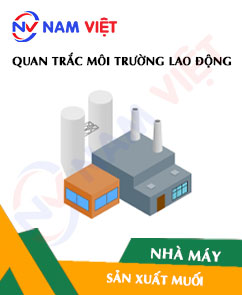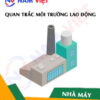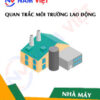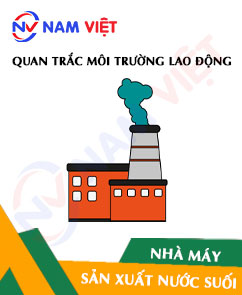Occupational environment monitoring at the factory producing salt
99,000 ₫
Note: The above price is calculated for one sample. Prices may fluctuate depending on the area of the environment to be monitored and market conditions. For more accurate pricing support, please refer to the price list or contact our consulting staff directly.
Workplace environment monitoring for a salt production factory is a session of collecting, analyzing, and evaluating factors at the workplace that may be harmful to workers health.
Table of Contents
Toggle1. Overview of Salt Production Factories
a. What is a salt production factory?
A salt production factory is an industrial facility specializing in producing salt from natural salt resources such as the sea, lakes, ponds, or by extracting salt from salt deposits. Salt production factories typically have equipment and systems to collect, process, and refine salt into various products to meet market demands.
The main stages in the salt production process in the factory include:
- Collection: Natural salt resources such as the sea, lakes, and ponds are collected using methods like salting, irrigation, or extraction from salt mines.
- Processing: The collected salt is processed to remove impurities, dirt, and other substances that may be present in the salt source. Processing methods may include water flushing, precipitation, filtration, or using steam systems.
- Refining: Salt is processed into different salt products such as refined salt, sea salt, table salt, mineral salt, or other special salt products. The refining process may include drying, purification, sterilization, and packaging.
- Quality control: Salt samples from the production process are taken and tested to ensure compliance with quality and safety standards.
- Packaging and transportation: Salt is packed into appropriate packaging and prepared for distribution to retail points or customers.

b. Production stages in a salt production factory
The production stages in a salt production factory typically include the following:
- Salt resource collection: This involves collecting salt from sources such as the sea, lakes, ponds, or extracting salt from salt deposits.
- Brine processing: Saltwater is extracted from the salt source and processed to separate salt from water. This process typically includes methods such as salting, irrigation, or other methods depending on the salt source.
- Pre-treatment steps: Before salt is produced, there may be several pre-treatment steps to remove impurities, dirt, or other substances present in the brine. This usually includes filtration, water flushing, or other methods.
- Salt formation process: The brine is placed into storage ponds or bottom tanks to allow water to evaporate, forming salt crystals. The salt formation process is usually carried out under specific environmental conditions, such as temperature, sunlight, and time.
- Salt processing stages: After salt forms, additional processing may be required to separate salt from impurities, dirt, and other substances. These stages include frequent filtration, washing, drying, refining, and salt filtration.
- Packaging and transportation: Salt is packaged into suitable containers, such as plastic bags, boxes, or jumbo bags, and prepared for distribution to retail points or customers.

c. Types of machinery used in salt production factories
In salt production factories, several types of machinery are used to perform production processes. Below are some common machines used in salt production:
- Brine extraction machines: These are used to extract brine from salt sources such as the sea, lakes, or ponds. Brine extraction machines can include water pumps or drainage systems.
- Water treatment systems: Machinery and equipment used to treat brine include water filtration systems, aeration systems, wastewater drainage systems, and other equipment to separate salt from water.
- Salt storage ponds: Machinery and equipment used to create and manage salt storage ponds, including bottom tanks and water pumps during the salt formation process.
- Evaporators: Evaporators are used to boil brine and evaporate water to produce salt. Evaporators can include boiling devices or steam spraying machines.
- Drying machines: Drying machines are used to dry salt after it has formed. Dryers can be direct or indirect, depending on the specific production process.
- Packaging machines: Packaging machines are used to pack salt into containers or according to customer requirements. Packaging machines can include bagging machines, boxing machines, or automated packing systems.

d. Occupational diseases that salt factory workers may face
Workers in salt production factories may be exposed to several occupational hazards related to the working environment and salt production process. Below are some common occupational diseases:
- Respiratory diseases: Workers may be affected by salt dust and fumes during salt production, causing respiratory issues such as bronchitis, pneumonia, coughing, shortness of breath, and reduced respiratory function.
- Skin diseases: Prolonged contact with salt can cause skin damage, including dermatitis, redness, itching, and eczema.
- Eye diseases: Exposure to salt dust or fumes may cause irritation and damage to the eyes, resulting in infections, redness, itching, and dryness.
- Musculoskeletal disorders: Jobs requiring physical effort and continuous movement may lead to stress and damage to bones, joints, and muscles, causing back pain, neck pain, joint degeneration, and arthritis.
- Hand and finger conditions: Continuous handling of salt may result in injuries, cuts, infections, and allergies to fingers and hands.
To ensure safety and protect workers’ health, personal protective measures should be implemented, including wearing protective equipment such as masks, gloves, safety goggles, and chemical-resistant clothing. Additionally, maintaining workplace hygiene, limiting exposure to harmful substances, and providing occupational safety training are important measures to reduce occupational disease risks.

e. Common types of salt on the market
There are various types of salt available on the market, suitable for culinary and other purposes. Below are some common types:
- Sea salt: Extracted from seawater through evaporation. It has a high natural mineral content and a rich flavor. Sea salt can be in large or small crystals.
- Unbleached sea salt: This type of sea salt is not chemically processed for bleaching, retaining its natural color. It has high mineral and micronutrient content.
- Table salt: Commonly used in daily cooking. Table salt is often iodized to prevent iodine deficiency.
- Himalayan pink salt: Mined from Himalayan salt deposits, it has a characteristic pink color due to minerals such as iron, magnesium, calcium, and potassium. It also has a unique taste and is commonly used in cooking and food decoration.
- Black salt: Salt with a black or dark color, often due to sulfur minerals. Black salt usually has a distinctive flavor and is suitable for garnishing dishes.
- Kosher salt: Used in Jewish cuisine and meets technical and nutritional standards for food preparation in Jewish culture.
2. Overview of occupational environmental monitoring services
a. What is occupational environmental monitoring at a salt production factory?
Occupational environmental monitoring (or workplace environment measurement) at a salt production factory involves collecting, evaluating, and analyzing measurement indicators of occupational environmental factors at the factory. The goal is to take timely measures to mitigate environmental hazards affecting workers’ health and prevent occupational diseases. Occupational environmental monitoring is mandatory for salt production factories.
Occupational environmental monitoring plays a crucial role in caring for, protecting, and enhancing workers’ health, as employees are the main resource and directly generate profit for the enterprise. Workers regularly exposed to risk factors exceeding permissible limits may suffer health impacts and develop occupational diseases.
REGISTER FOR OCCUPATIONAL ENVIRONMENT MONITORING SERVICE
b. An Toan Nam Viet’s occupational environmental monitoring program
An Toan Nam Viet’s occupational environmental monitoring program is developed by monitoring engineers in the fields of occupational safety and environmental protection. With the goal of ensuring workers’ health and safety, the program uses modern measurement methods to monitor air quality, water quality, and microclimate, physical, and dust factors in the working environment. This program is vital for ensuring a safe workplace and protecting workers’ health.
Additionally, An Toan Nam Viet’s monitoring program is important for researching and developing new solutions to improve occupational environmental quality. With the dedication and professionalism of the monitoring team, An Toan Nam Viet’s exclusive program is becoming a breakthrough in occupational safety management and environmental protection in Vietnam.

c. Standardization in occupational environmental measurement procedures
Standardization in An Toan Nam Viet’s occupational environmental measurement procedures is crucial for ensuring measurement quality. To ensure accuracy and reliability of the results, the program follows standards and standardized procedures recognized by the Ho Chi Minh City Department of Health. This ensures that the collected data is highly reliable for assessing the workplace environment and making decisions to improve the working environment to protect workers’ health.
These standardized procedures also ensure that measurements are conducted by highly qualified monitoring specialists with years of experience, allowing managers and experts to rely on An Toan Nam Viet’s results and make accurate, valuable decisions to protect workers and the environment.
By applying standardization in occupational environmental measurement, An Toan Nam Viet demonstrates its commitment to ensuring a safe working environment and protecting workers’ health, while also contributing positively to improving occupational safety management and environmental protection in Vietnam.
d. Reporting results of occupational environmental monitoring in salt production factories
Occupational environmental monitoring results are prepared according to Form No. 04, Appendix III, issued with Decree 44/2016/ND-CP and are prepared in two copies: one sent to the enterprise that contracts the monitoring service, and one kept at the monitoring organization.
The retention period for occupational environmental monitoring results is indefinite, as per legal regulations.

e. Frequency of occupational environmental monitoring as per the law
According to Clause 2 of Article 18 of the Law on Occupational Safety and Health 84/2015/QH13, employers must organize occupational environmental monitoring to evaluate harmful factors at least once a year.
f. Deadline for submitting occupational environmental monitoring reports as per the law
The deadline for submission is before December 31 each year. Enterprises operating production factories are required to submit occupational environmental monitoring reports to the local Department of Health where the enterprise is headquartered and where workers are employed.
If there are changes in technology, production processes, or factory upgrades that may generate new harmful factors affecting workers’ health, enterprises must update occupational hygiene records regarding harmful factors and conduct occupational environmental monitoring.
g. Penalties for violations of occupational environmental monitoring for employers
According to Article 27 of Decree No. 12/2022/ND-CP dated January 17, 2022, regulating administrative penalties in labor, social insurance, and Vietnamese workers working abroad under contract:
- Clause 2: A fine of VND 2,000,000 – 5,000,000 for employers who fail to publicly disclose monitoring results at the workplace and at the locations where hazardous factors are evaluated immediately after obtaining results of occupational environmental monitoring and hazard management inspections.
- Clause 3: A fine of VND 20,000,000 – 40,000,000 for employers who fail to conduct occupational environmental monitoring to control the impact on workers’ health as required by law.
- Clause 4: A fine of VND 40,000,000 – 60,000,000 for employers who collude with monitoring organizations to falsify occupational environmental monitoring activities but do not reach the level of criminal liability.
3. Harmful environmental factors for workers in salt production factories
Workers in salt production factories may be exposed to several harmful environmental factors. Here are some environmental factors that can be harmful to workers in the salt industry:
- Salt dust: The salt production process can generate salt dust in the air. Inhaling salt dust can irritate the throat, nose, and lungs, causing discomfort and difficulty breathing.
- Salt fumes: During salt boiling, salt fumes may be released into the workspace. Inhaling salt fumes can cause nasal dryness, sore throat, and breathing difficulties.
- Tropical environment: Some salt factories are located in tropical areas. Tropical conditions can cause discomfort, fatigue, and difficulty working.
- Humidity: Salt production often involves water handling, especially during boiling. This can increase humidity in the work environment, causing discomfort, dampness, and potential harm to the skin and respiratory system.
- Strong lighting: Some salt factories use strong lighting to support the boiling process. Intense light can cause eye strain and discomfort for workers.
REGISTER FOR OCCUPATIONAL ENVIRONMENT MONITORING SERVICE
4. Measures to improve working conditions in salt production factories
To improve working conditions and protect workers’ health in salt factories, the following measures can be implemented:
- Ventilation and exhaust fans: Ensure the factory has an effective ventilation system to clean the air and remove salt dust and fumes. Strong exhaust fans should be used to provide fresh airflow and eliminate polluted air.
- Air filtration system: Install air filtration systems to remove salt dust and fumes from the air. Filters help maintain air quality in the factory and prevent inhalation of harmful salt particles.
- Occupational safety and protective equipment training: Ensure workers are trained in occupational safety, recognize potential hazards in salt production, and know how to properly use personal protective equipment such as masks, goggles, protective clothing, gloves, and safety shoes.
- Regular inspection and maintenance of equipment: Conduct regular inspections and maintenance of machinery, equipment, and systems to ensure effective and safe operation. This includes checking and cleaning ventilation systems, motors, and other components for stable operation.
- Waste management: Ensure safe and legal management of waste. Waste from salt production may contain harmful substances and should be handled properly to prevent environmental pollution and health risks.
- Periodic health checks: Conduct regular health checks for workers to detect early health issues potentially related to working in salt factories.
- Noise reduction: Noise may be an issue in certain salt production processes. Apply measures to reduce noise such as sound insulation, noise-reducing equipment, and ensure workers are provided with protective ear equipment when necessary.
- Periodically conduct occupational environment monitoring in factories to collect and analyze harmful factors for workers, and adjust measures to reduce risks and prevent occupational diseases.
5. Benefits of periodic monitoring in salt production factories
An Toan Nam Viet provides businesses with excellent benefits when using occupational environment monitoring services in accordance with Decree 44/2016/ND-CP on the management and control of harmful workplace factors affecting workers.
- Businesses can proactively control harmful factors in workshops or factories.
- Receive recommendations on measures to reduce harmful factors and improve workplace quality.
- Indirectly protect human resources, a key factor in business development.
- Reduce the impact of occupational diseases on worker health, minimizing future treatment costs.
- Improved worker health leads to higher product quality and consistent output.
- Ensure compliance with labor safety regulations and avoid legal risks.
- Enhance credibility and professionalism, elevating the company’s brand.
Nam Viet’s environmental monitoring service is a solution to mitigate occupational disease risks, contributing to a clean and high-quality working environment.

6. National occupational environment monitoring center
Occupational environment monitoring center of Nam Viet is a professional unit specializing in monitoring and measuring workplace environmental quality across all provinces in Vietnam. With a team of experienced monitoring specialists, the center uses modern measurement equipment to ensure accuracy and reliability.
In addition to monitoring services, the center supports clients in planning, managing, and tracking occupational environmental issues. With the motto “customer-centered,” the center prioritizes client satisfaction, meets all client needs, and provides the best solutions for businesses.
REGISTER FOR OCCUPATIONAL ENVIRONMENT MONITORING SERVICE
With investments in technology, equipment, and human resources, Nam Viet’s monitoring center has become one of the most reputable units in occupational environment monitoring in Ho Chi Minh City, with the following objectives:
- We always value our brand reputation and the quality of our service products.
- We provide clients with the best and most suitable solutions possible.
- With a team of experienced Masters and Engineers committed to environmental protection and business benefits.
- By choosing Nam Viet Environmental Monitoring, companies receive professional service from experts and the best cost advantages.
The occupational environment monitoring process at Nam Viet includes the following basic steps:
- Before monitoring, the company ensures all equipment is calibrated according to legal regulations.
- Follow the occupational environment monitoring procedures accurately as committed to the Department of Health.
- Report monitoring results honestly to employers.
- If monitoring results indicate unsafe conditions, Nam Viet provides corrective solutions, and the workplace implements the following:
- Implement measures to improve working conditions, minimize harmful factor impacts, and prevent occupational diseases.
- Conduct health examinations to detect occupational and related diseases early for workers in unsafe environments.
- Provide in-kind compensation to workers according to labor law.

7. Occupational environment monitoring quotation
To help businesses conduct professional and effective occupational environment monitoring, Nam Viet provides clients with a quotation for occupational environment monitoring services that is high-quality and reasonably priced.
- Our quotation provides detailed pricing information for the monitoring services we offer, including costs related to travel, measurement, analysis, and reporting. Clients can trust the accuracy and reliability of our monitoring reports.
- We commit to offering competitive and reasonable prices in the market and are always ready to provide quick and professional advice for any service inquiries.
- With Nam Viet’s quotation, clients can easily select service packages suitable to their needs. We are committed to delivering the highest satisfaction with professional service quality.
No comments yet












Review Occupational environment monitoring at the factory producing salt
There are no reviews yet.